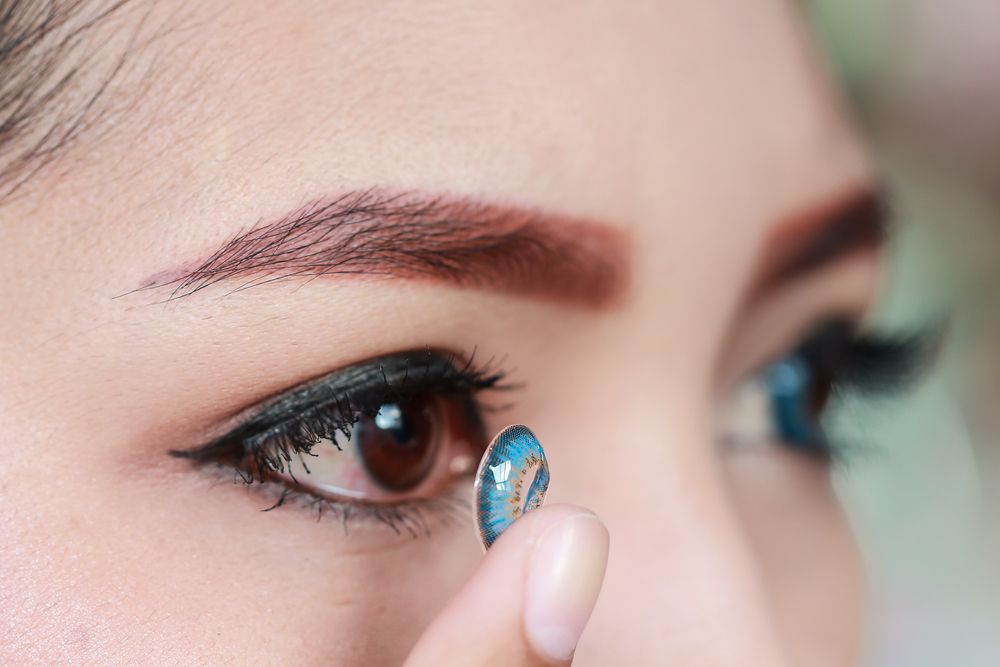For many people, eyewear is more than a vision correction tool—it’s also a way to express personality and style. Colored contact lenses offer a unique opportunity to enhance or completely change your eye color, allowing for subtle shifts or dramatic transformations. Whether you’re aiming for a natural enhancement or a bold, fashion-forward statement, colored lenses can provide a fun and impactful way to personalize your look. For residents of Greenwood Village and Denver, CO, this educational article from Dr. Abed Namavari of Colorado Eye Clinic explores everything you need to know about colored contact lenses, from types and aesthetics to safety and usage.
Understanding the Different Types of Colored Lenses
Colored contact lenses come in a variety of tints, each designed for different purposes and visual effects. The most common categories include visibility tints, enhancement tints, and opaque tints. Visibility tints are typically light blue or green and do not alter the natural color of the eye; instead, they help make the lenses easier to see during handling. These are particularly helpful for first-time users or anyone who frequently misplaces clear lenses.
Enhancement tints are slightly darker and are intended to enrich the existing eye color rather than change it. They are best suited for people with light-colored eyes who want a subtle yet noticeable boost in vibrancy. Opaque tints, on the other hand, are designed to completely mask the natural eye color and are ideal for those with dark eyes or those looking for a dramatic transformation. These lenses are often used for cosmetic purposes, including fashion, performance, or costume wear, and are available in a wide range of colors such as blue, green, hazel, violet, or even more unconventional shades like red or white.
Colored lenses may also come in prescription and non-prescription forms. Prescription versions correct refractive errors while providing a color change, whereas plano (non-prescription) lenses serve purely aesthetic purposes. Regardless of the type, all colored lenses must be properly fitted and cared for to ensure eye safety.
Aesthetic Appeal and Personal Expression
One of the primary reasons people opt for colored contact lenses is to experiment with their appearance. Eye color is a defining facial feature, and changing it can significantly alter a person’s overall look. Whether you want to make your blue eyes brighter, try a warm hazel tone, or completely reinvent your gaze with a bold violet or gray shade, colored lenses offer near-instant transformation without long-term commitment.
Colored lenses are also a popular accessory for special events, such as weddings, photo shoots, or theatrical performances. Makeup artists and fashion stylists often use them to complement specific looks or enhance themes. With the growing popularity of cosplay, fantasy-inspired styles, and themed costume parties, colored lenses have become a go-to accessory for creating unique and memorable characters.
Beyond aesthetics, changing eye color can offer a fresh start or boost in confidence for some individuals. Just as someone might experiment with different hair colors or clothing styles, colored contact lenses can be a powerful tool for self-expression. The ability to try on a new identity—even temporarily—can be a liberating and empowering experience.
Safety Concerns and Risks to Be Aware Of
Despite their appeal, colored contact lenses are not without risks. Any contact lens, regardless of whether it’s for vision correction or cosmetic use, is considered a medical device. Improper use or handling can lead to serious eye health issues, including infections, allergic reactions, and even vision loss. One common misconception is that non-prescription colored lenses sold online or in costume shops are harmless. However, lenses that are not properly fitted by an eye care professional may not sit correctly on the eye, increasing the risk of scratches, irritation, or infection.
It is crucial that all colored contact lenses be obtained through a valid prescription, even if vision correction isn’t needed. An eye doctor will assess the shape and health of the eye to ensure the right fit, and they can also provide important guidance on proper cleaning, storage, and wear time. Over-wearing lenses, sleeping in lenses not designed for overnight use, or failing to clean them correctly can all increase the risk of complications such as corneal ulcers or keratitis.
Additionally, the dyes and pigments used in some low-quality colored lenses can reduce oxygen flow to the cornea, making them uncomfortable or even dangerous to wear. Trusted brands and regulated products undergo rigorous testing to ensure they are safe for use, while cheap or counterfeit lenses may contain materials that do not meet medical standards. Choosing quality over cost is essential when it comes to something as delicate and important as your vision.
Daily Wear vs. Extended Wear: What’s the Best Option?
Colored contact lenses are available in several wear schedules, including daily, bi-weekly, and monthly options. Daily disposables are typically considered the most hygienic choice because they are discarded after one use, which minimizes the risk of contamination and eliminates the need for cleaning solutions. They are ideal for occasional wearers who want to change their look for special events or weekends without the burden of maintenance.
Bi-weekly and monthly lenses are more cost-effective for frequent wearers, but they require strict adherence to cleaning routines and storage protocols. These lenses must be disinfected daily using a recommended solution and stored in a clean case. Failure to maintain this routine can quickly lead to buildup of protein deposits, bacteria, or fungi on the lens surface, all of which can compromise eye health.
It’s important to follow the manufacturer’s guidelines and your eye doctor’s recommendations regarding lens replacement. Extending wear time beyond what is prescribed can lead to decreased comfort and increased risk of complications. While it might be tempting to stretch out the life of a lens to save money, doing so can end up costing more in terms of eye health and medical care in the long run.
Best Practices for Lens Care and Hygiene
Proper lens care is vital when it comes to wearing colored contacts safely. Regardless of whether the lenses are worn for vision correction or cosmetic purposes, hygiene should be a top priority. Always start with clean, dry hands before touching lenses. Use a recommended multipurpose solution to clean and rinse the lenses each time they are removed. Never use tap water, saliva, or expired solution as substitutes, as these can introduce harmful bacteria.
The lens case should also be cleaned and allowed to air dry daily, and it should be replaced at least once every three months. Avoid wearing lenses when swimming or showering unless you’re using specialized lenses designed for water use. These practices reduce the risk of Acanthamoeba and other waterborne parasites that can lead to severe eye infections.
Users should also pay attention to any signs of eye discomfort, redness, excessive tearing, or blurred vision. These could indicate a problem with the lenses or an underlying eye issue. In such cases, it’s important to remove the lenses immediately and consult an eye care professional before resuming use.
Considering the Right Look for Your Eyes
When selecting colored contact lenses, it’s helpful to consider your natural eye color, skin tone, and the overall effect you’re trying to achieve. Some lenses are designed to blend with your natural color for a more realistic look, while others provide full coverage for a bold transformation. Trying out different options with professional guidance or using virtual try-on tools can help you find the most flattering shade.
For example, those with light eyes might find that enhancement tints provide a beautiful yet subtle shift in hue, while individuals with dark eyes may need opaque lenses for noticeable changes. Certain shades may also work better with specific skin undertones—cool tones may be complemented by gray or violet lenses, while warm tones may shine with honey or hazel hues.
Ultimately, the right choice depends on personal preference and how dramatic or natural you want the change to be. Whether you’re experimenting for fashion, performance, or everyday flair, colored contact lenses can be a fun and safe way to play with your appearance—when used responsibly.
Conclusion
Colored contact lenses offer an exciting blend of cosmetic transformation and personal style. They provide a unique way to enhance or reinvent your appearance, whether for a special occasion or daily confidence boost. However, these lenses also come with responsibilities that should not be taken lightly. From choosing the right type and color to following essential safety guidelines, proper use is key to enjoying colored contacts without compromising eye health.
For those in Greenwood Village and Denver, CO, resources like this guide from Dr. Abed Namavari and the Colorado Eye Clinic offer valuable information to help individuals make informed decisions about colored contact lenses. By balancing style with safety, users can enjoy the creative possibilities of colored lenses while maintaining healthy, clear vision.
Resources:
- Young, G., Coleman, S., & Hunt, C. (2002). Clinical Performance of Cosmetic Contact Lenses. Optometry and Vision Science.
- Stapleton, F., & Keay, L. (2013). The Epidemiology of Contact Lens Related Infiltrates. Optometry and Vision Science.
- Szczotka-Flynn, L., & Barr, J. T. (2006). Daily Versus Extended Wear Contact Lenses: A Clinical Comparison. Contact Lens and Anterior Eye.

